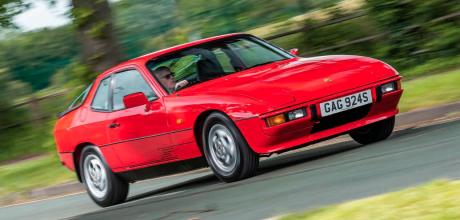S-express Paul Webster’s restored 1988 Porsche 924 S
The days of the 924 being considered the ‘poor man’s Porsche’ are happily behind us, but this means being able to pay peanuts for a tidy example of the front-engined, water-cooled coupe is also a thing of the past. Fret not, for attractively priced 924s are still out there, but you’ll need to act fast if you want to take advantage of this low-cost entry point into Porsche ownership...
Words Dan Furr and Richard Gooding
Photography Dan Sherwood
Despite the criticism it was subjected to as a consequence of joint Volkswagen-Porsche parentage, the mid-engined 914 of 1969 paved the way for a different kind of thinking in Stuttgart. The boxy, Targa-topped roadster was a sales success shifting almost 119,000 units, proving there were huge benefits for the two manufacturers to work closely with one another when developing new vehicles. It’s a relationship which can trace its roots to a time before Porsche existed as a car maker and one galvanised with the development of the company’s first Beetle-derived offerings. While it’s rare to find anyone criticise the 356, however, VW’s influence in later Porsche sports car design wasn’t always as warmly appreciated.
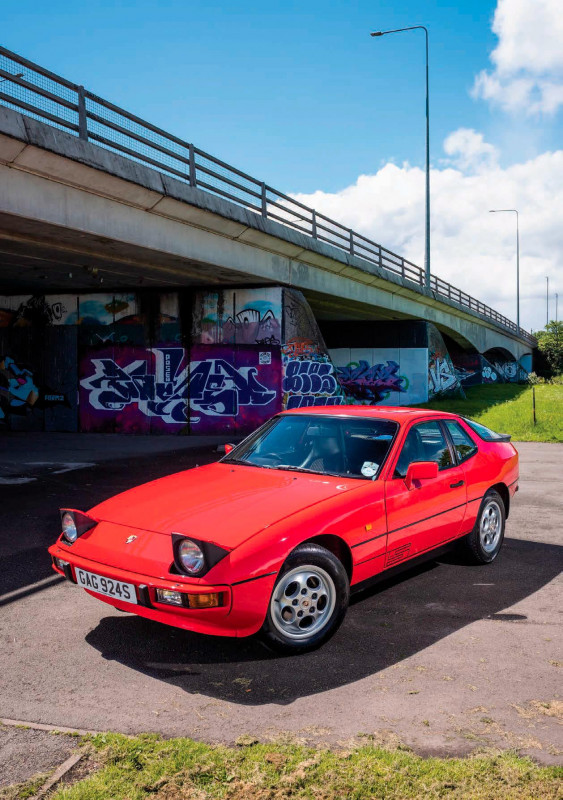
Facing page UK buyers needed £21k to bag themselves a 924 S in 1988, whereas less than half that sum will buy you a surviving example of the same model in excellent condition today.
1972 saw the beginning of a project codenamed EA425. The work formed part of Porsche’s contract to design and produce new products for VW, and as such, the sporty coupe being developed had a silhouette unlike any Porsche up until that point in time. Designed by Porsche stylist, Harm Lagaay (he of 993, Carrera GT, 996, Boxster and Cayenne fame), the new model featured a smooth nose and pop-up headlights harking back to the styling of the 914, but that’s where similarities ended — from front to rear, the project car’s body rose wedge-like to a curved tailgate. This was quite unlike anything else Porsche had produced.
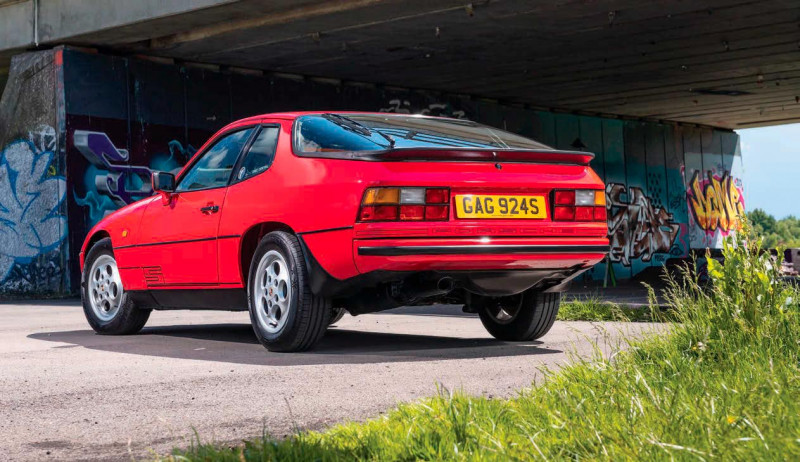
Above Closer in specification to the 944 than 924, the S retains the 924’s narrow quarters, but boosts performance to 150bhp thanks to the Porsche 2.5-litre M44 inline-four.
Despite already being a long time in development, the slipperier 928 was a few years away from being revealed. The grand tourer’s radical departure from the rear-engined, air-cooled configuration of the 911 inspired Porsche engineers to adopt the same ‘engine at the front, transmission at the rear’ layout for the new range-topping VW, which was due to be launched just as the last 914s rolled out of main dealer showrooms in 1976. The Wolfsburg concern’s bosses, however, got cold feet in the wake of the global oil crisis occurring little more than a year into the project. Sensing they’d be better off investing their time and energy in the upcoming Golf and Scirocco, they called time on EA425.
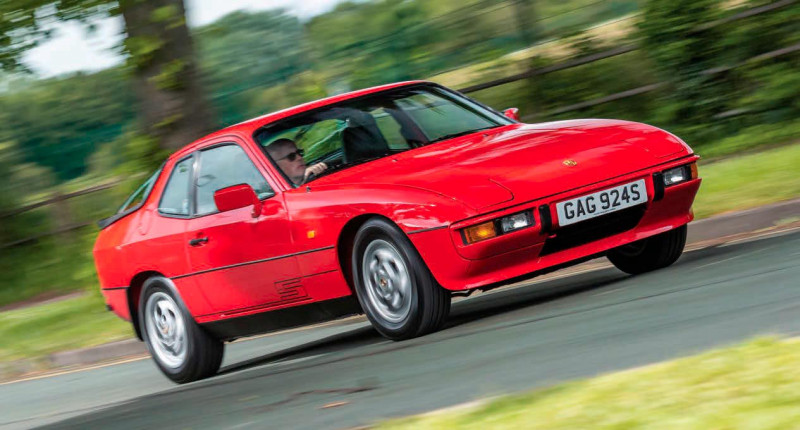
Porsche had invested a huge amount of its resources into the project, leading the company to come to an agreement with VW, whereby Porsche would acquire rights to EA425 regardless of VW’s involvement (and as a direct result of the Wolfsburg concern’s loss of confidence). Part of the deal included vehicle assembly at the old NSU factory at Neckarsulm, with VW named as subcontractor —its employees would assemble the new car under Porsche supervision. Marketed as an entry-level Porsche, the resulting coupe was badged 924 and leap-frogged the 928 in being the first model available as a radical reworking of the Porsche sports car concept.
OPTIONS INCLUDED A PORSCHE-MADE CLOSE-RATIO FIVE-SPEED MANUAL GEARBOX OR AN AUDI-SOURCED THREE-SPEED AUTOMATIC
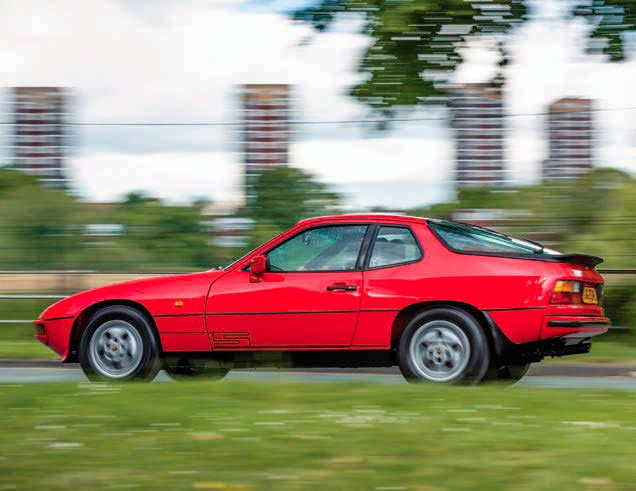
Happy with the completed design and its component make-up, Porsche launched the 924 in 1975 with a basic recipe of VW-Audi ingredients. A 1,984cc, water-cooled, four-cylinder engine linked to a rear-mounted Audi four-speed gearbox and differential powered what would go on to be recognised as the first production model in Porsche’s transaxle series of cars. A near perfect 52/48 front/rear weight distribution, however, did nothing to convince Porsche purists alarmed at the lack of air-cooled engine and modest output. Admittedly, the first 924 was a tad underpowered, but it was a well-balanced steer in true Porsche tradition. Even so, critics chose to ignore the car’s better qualities, lazily referring to it “a Porsche with a van engine”, referring to the four-cylinder EA831. While it’s true to say this unit was used in the VW LT cargo carrier, it had started life at Audi and went on to propel the Ingolstadt manufacturer’s popular 100. The 924’s detractors had got it wrong — the EA831 used for 924 production was topped with a Porsche cylinder head, replacing Audi-favoured Weber/Holley carburettors with Bosch K-Jetronic fuel injection. Power for cars marketed in Europe was 125bhp with 121.5lb-ft torque.
Below The 944’s 2.5-litre M44 inline-four engine, supporting suspension components and brakes were ported over to the 924, resulting in the 924 S, the only variant available in the 924 range from S model launch until discontinuation in August 1988.
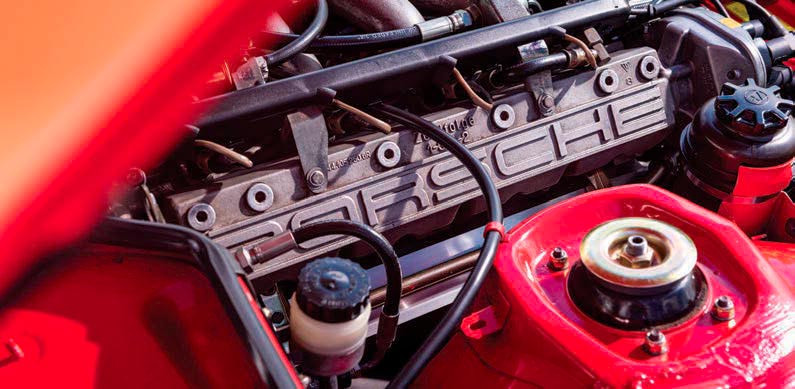
BIG HITTER
A Stateside launch in July 1976 saw the 924 prove popular from the off, despite anti-smog kit reducing power to 95bhp. In fact, 4,544 924s were sold in the first five months and no fewer than 13,696 924s found homes in the US during the course of the next year. Without doubt, the first product from transaxle line-up was a roaring success, so much so that during the 1977 model year, 23,180 924s were produced.
Though Lagaay wouldn’t have predicted as much, during its twelve-year production run, the 924 was often listed as the world’s best-selling sports car. Performance was similar to the two-litre 914 of 1973 insofar as European 924s managed the dash from nought to 62mph in 10.5 seconds, while top speed was rated at 125mph. MacPherson struts featured at the front, with a more conventional, Beetle-derived transverse torsion bar setup at the rear. An amazing tally of 50,000 924s were built in just twenty-six months. UK deliveries started in January 1977, with early cars priced at £6,999. Options included a Porsche made close-ratio five-speed manual gearbox or an Audi-sourced three-speed automatic. For the 1978 model year, US-bound (emission-controlled) cars gained catalysts and a boost to 110bhp, which was upped to 115bhp in 1980. All 924s gained uprated shocks, rubber bushes and an oval-tipped exhaust.
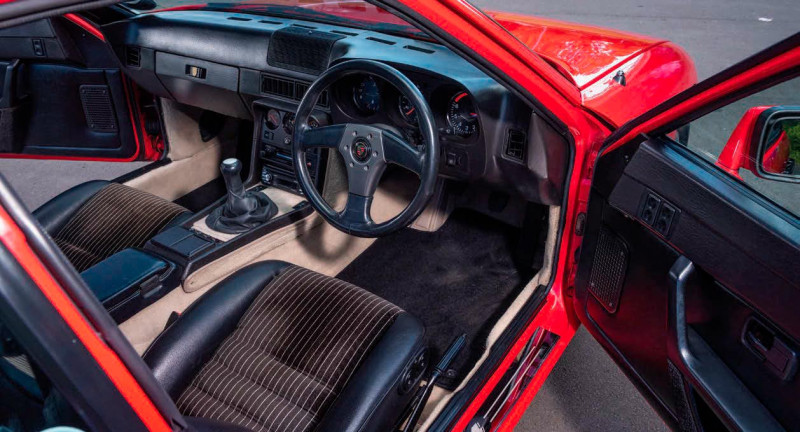
Above 924 ‘square’ dashboard was also a feature of early 944s, the design superseded by the 944 Turbo’s superior ‘oval’ dash, subsequently rolled out across the 944 range and carried over to the 968.
From the highs of 1977, the following year delivered a sharp decline in sales. This was particularly apparent in the USA, where the number of 924s sold slumped to just 10,483 units. A look into Zuffenhausen’s crystal ball delivered what many hoped would be the answer — inspired by the 911 Turbo (930), the turbocharged 924 was about to make its mark on the automotive landscape. The creatively named 924 Turbo was unveiled in the spring of 1978, packing a 170bhp punch assisted by a fresh alloy cylinder head, reduced compression ratio of 7.5:1 and a KKK K-26 turbocharger.
THE INCREASE IN DISPLACEMENT WARRANTED A NEW NAMEPLATE, THUS THE 924 S WAS INTRODUCED FOR THE 1986 MODEL YEAR
Arguably the car the 924 should have been from the start, the Turbo rewarded those with a keen eye — four front-mounted intake vents fed air to a standalone oil cooler, grilles appeared beneath the spotlights and a NACA duct was integrated into the bonnet. Fifteen-inch latticed alloys differentiated the model from its less potent stablemates, as did a polyurethane rear window spoiler. A choice of twin-tone paint jobs ensured the force-fed transaxle was hard to miss.

Torque was up to 180lb-ft. The 924 Turbo scampered to 62mph from rest in 7.8 seconds and topped-out at 140mph. A five-speed G31 gearbox was linked to an engine built in Stuttgart, even if the basic design was similar to the powerplants rolling off VW’s Salzgitter lines. Bilstein gas dampers and a larger brake servo added to enviable specification, but even with the extra kit, the 1,180kg Turbo weighed only fifty kilos more than the naturally aspirated 924. Unsurprisingly, US-destined 924 Turbos were less powerful, registering just 150bhp, but in all other respects, the 924 was, at last, a true performance Porsche.

Above Many parts are interchangeable across the four-cylinder transaxle family of products, including seats, such as the 944 ‘tombstones’ fitted to Paul’s 924 S.
The first 924 Turbos for the UK market arrived in November 1979. Standard 924s were updated with five-speed gearboxes at the same time. Priced at £13,629, the range-topper was an attractive buy, yet a far hotter 924 was waiting in the wings. Revealed at the 1979 Frankfurt Motor Show, the 924 Carrera GT prototype was a sexier, more muscular version of the water-cooled Porsche. 210bhp, aggressive wings and matching rear quarters (bodywork designed by Porsche styling hero, Tony Lapine) suggested the new car had been assembled with a particular task in mind: to go racing at Le Mans. In 1980, the 924-on-steroids did exactly that. Moreover, it delivered the goods convincingly, the highest-placed 320bhp 924 Carrera GTP finishing in sixth place.
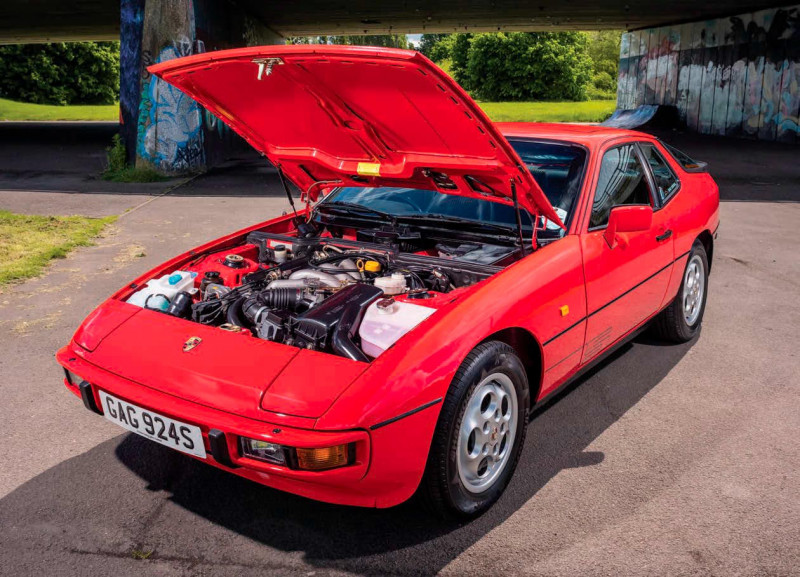
Above Paul has worked hard to bring his 924 S to its current condition, which impressed Porsche Centre Wolverhampton enough for the car to appear on the dealership’s display stand at recent events.
Further distinguished by Fuchs alloys, a full-on bonnet scoop and lowered ride height, GT giveaways include Carrera script body graphics down each flank. Production started in August 1980 for the 1981 model year. At the same time, 924 Turbo power was upped to 177bhp. It’s worth noting how even without a hike in horsepower, the first-generation 924 Turbo was the world’s most powerful two-litre production car. At £19,000, meanwhile, the scorching 924 Carrera GT boasted similar price and performance as the three-litre 911. Only 406 Carrera GTs were built. Of those, just seventy-five were configured with right-hand drive. The 6.7 seconds it took for the model to hit 62mph from a standing start is well regarded in Porsche circles, but even the GT can’t lay claim to being the rarest 924.
1981 saw the arrival of fifty-nine ‘evolution’ 924 Carrera GTS models. The sprint from rest to 62mph was achieved in just 6.2 seconds, bolstered by a stratospheric-for the-time top speed of 155mph. At DM110,000, the GTS was far from cheap, but buyers were rewarded with the aluminium doors and bonnet previewed on the Carrera GT prototype from two years earlier. The GTS also boasted the 930’s cross-drilled brake discs. A Clubsport version of the GTS attracted an additional DM35,000. You got a Matter roll cage and racing seats in exchange for your hard-earned cash. You could also tell your friends how your fancy new 924 boasted a prodigious zero to 62mph sprint time of 5.9 seconds and top speed of 161mph. Nineteen 375bhp GTP-alikes labelled GTR arrived later, representing the ultimate development of the 924 in race trim.
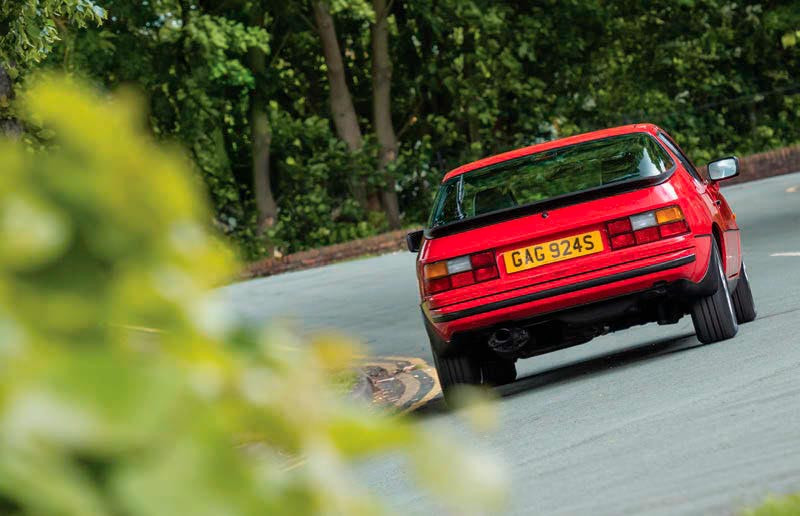
HOT TOPIC
But wait! Isn’t this article supposed to be about the 924 being an affordable route into Porsche ownership? Quite right — while it’s important to promote the 924’s bona fide race car heritage, particularly in view of the model having been dismissed by so many for so long, let’s leave these exotic track-oriented transaxles for another day and return to the cars most likely to register on your radar.
THE REAR HATCH LIFTS TO ACCOMMODATE A SURPRISING AMOUNT OF LUGGAGE AND THE BACK SEATS WILL WELCOME SMALL ADULTS
The 924 Turbo was dropped from Porsche’s product range in 1982, but not before being treated to the newly launched 944’s front suspension and steering components. Itself developed from the 924 and featuring bodywork based on that of the 924 Carrera GT, the base 944 used a new Porsche-designed 2.5-litre inline-four producing 163bhp. Classed by the motoring press as more of a ‘genuine’ Porsche than the 924 (primarily on account of its purely Porsche engine), the newer car sat squarely between the 924 and 924 Turbo. It was a huge hit, kickstarting the 944’s near ten years on assembly lines, a decade accounting for the 944 being the most successful Porsche product in the company’s history prior to the arrival of the Cayenne SUV and 986 Boxster.
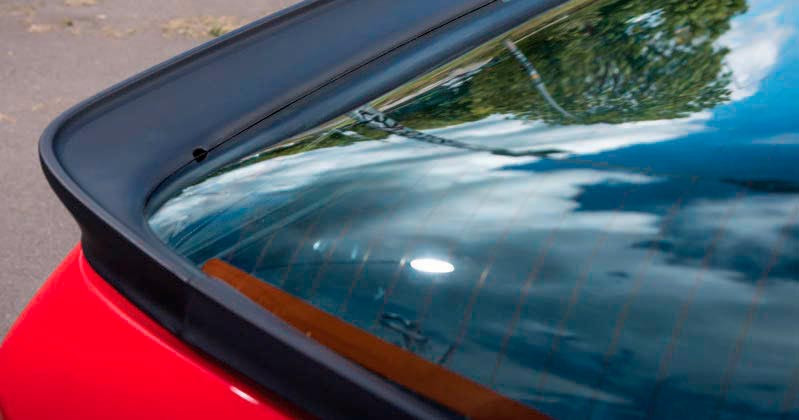
February 1982 saw the 100,000th 924 produced. All 924s gained the 944’s updated interior and rear spoiler. Sales passed 130,000 units in 1983, while detail changes extended the two-litre variant’s life until 1985, at which point VW ceased production of the EA831 engine. Audi had dispensed with it in 1979, summoning the lighter and more efficient EA 827 to serve in its place. In contrast, Porsche had no desire to develop a new two-litre engine with which to power its entry-level offering. With VW calling time on the EA831, quick thinking was required from the engineers in Zuffenhausen.
THE FACT THE 924 S IS A PURELY PORSCHE PRODUCT MAKES SPARES MORE EXPENSIVE THAN PARTS FOR THE TWO-LITRE MODEL
The answer came in the form of a detuned version of the 944’s 2.5-litre M44 inline-four. The increase in displacement warranted a new nameplate, thus the 924 S was introduced for the 1986 model year, when it became the only 924 available new from main dealers. Performance was on par with the discontinued 924 Turbo — 150bhp and 144lb-ft encouraged the dash to 60mph from a standing start in 7.8 seconds, while top speed was 137mph. The 924 S was not to be dismissed as simply an engine drop-in special, though.
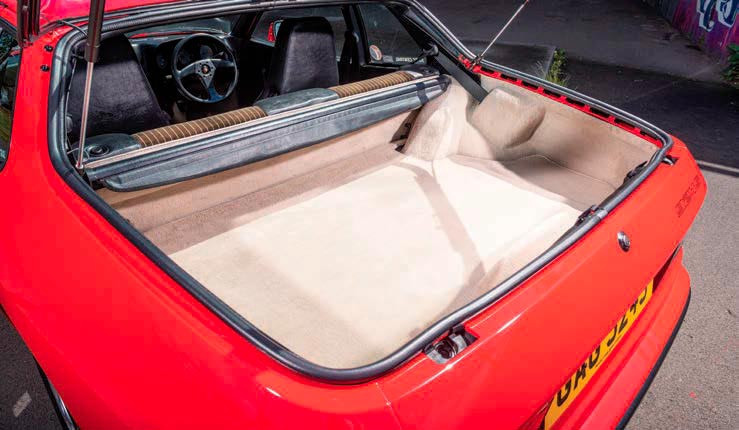
Right All models in Porsche’s brilliant transaxle family of products provide generous luggage space and the convenience of a modern hatchback.
Proving the point, Porsche raided its parts bin and equipped the 924 S with the 944’s disc brakes and part-aluminium rear semi-trailing arms. 924 S power rose to 160bhp in 1987. Late 1988 model year examples featured 944-style polyurethane front and rear skirts designed to improve airflow. As its registration plate suggests, the car you see on these pages is one such 924, first registered in April 1988 and currently owned by 911 & Porsche World reader, Paul Webster. He’s an active member of The Independent Porsche Enthusiasts Club (TIPEC) — some of you may recall seeing the car on the club’s stand at various events, including the annual Classic Motor Show, held at Birmingham’s National Exhibition Centre each November. “I’ve been in love with the 924 since the late 1970s, when a school friend’s father kept a two-litre example as his company car. Twenty years later, in 1999, I bought a 924 to call my own.”
RENNBOW BRIGHT
Another two-litre car, though registered in 1984, the Zermatt Silver Porsche was in need of significant work. “It wasn’t running right and the suspension was in a terrible state,” Paul recalls. “By then, 924s were falling into the hands of owners who weren’t keeping up with regular servicing and maintenance, a common condition relating to how low 924 values were during the period.” This is a point any prospective purchaser needs to keep in mind: though Porsche prices in general have risen sharply in recent years, there was a time many of the cars we love were worth a fraction of their current value. The budgets afforded to keeping them on the road were often commensurate with their purchase price, meaning it’s not unusual to discover a 924 was neglected in decades past. Reassuringly, with the model now considered a modern classic and afforded the respect it always deserved, values have climbed steadily and good examples are highly sought after. Even so, there’s every chance a well-presented 924 will be accompanied by paperwork outlining a chequered history until a marque enthusiast stepped in and showered time, money and elbow grease to bring the car back to its best.
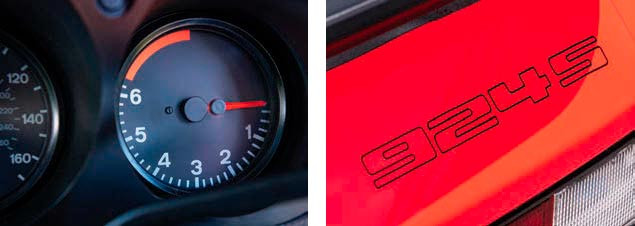
And so it was with Paul’s two-litre 924. A fifteen-year-old Porsche by the time his name appeared on its logbook, the car was swiftly treated to an engine-out rebuild. “These are brilliant Porsches for home mechanics to work on,” he beams, acknowledging the base model’s simple engineering, making it an attractive proposition for automotive DIY enthusiasts looking to get their hands dirty. This isn’t the case for everyone, which is why we recommend finding the best condition 924 you can lay your hands on, irrespective of its colour or specification. On the plus side, many surviving 924s are in the hands of enthusiasts who know these cars inside out, meaning most poor examples have already been despatched to the great scrapyard in the sky. If in doubt, consult with the dedicated 924 Owners Club (porsche924.co.uk). There’s every chance members will know the car you’re thinking about buying.
THE ENGINE SPRINGS TO LIFE IN THE MIDRANGE, WHERE FROM 3,000RPM, THIS THING REALLY PULLS
Paul carefully worked through his 924, but after returning it to the road in the best condition it had been in since rolling off the assembly line, he wasn’t bowled over by the car’s performance. “The handling of the 924 is fantastic thanks due to the near perfect front-to-rear distribution of weight, but even when these cars were new, their engine output didn’t set the automotive world alight.” Nevertheless, he stuck with the car for nine years until the occasion of his fiftieth birthday gave him all the excuse he needed to buy the Guards Red 924 S you see here.
Regardless of power output, all 924s marry classic styling with practicality — the rear hatch lifts to accommodate a surprising amount of luggage and the back seats will welcome children or small adults. Paul’s daughter, for instance, travelled in the back of his two-litre car for the first eighteen years of her life, during which the Webster family used the Porsche for road trips and overseas holidays. Nonetheless, be aware the lack of power-assisted steering and, as is the case with many two-litre 924s in need of a tune-up, being down on already conservative power can make the 924 feel heavy. Not so with the comparatively well-equipped 924 S, the variant best suited to coping with modern traffic. Paul’s 924 S had been left languishing in a field. Its sunroof seals were letting in water, the underside was covered in surface rust and dodgy race seats occupied the cabin, which, thanks to water ingress, was carrying damaged door cards. On the plus side, the car had been treated to a full respray and, in view of Paul being a hobbyist mechanic, this Porsche was the perfect doer-upper.

As far as the nuts and bolts are concerned, he hasn’t had to strip the engine, such is the M44’s reputation for being largely bulletproof in all its guises across three model lines (924, 944 and 968). The fuel tank was replaced and original-specification oil shocks were installed, as was new ignition and timing equipment, plus servicing consumables.
Above This particular 924 S’s ‘Teledials’ are, in fact, a set of four rear wheels from the limited-run 1988 924 Le Mans model
More recently, new engine mounts were fitted, contributing to the ‘magic carpet ride’ Paul knew the 924 S was capable of. Zuffenhaus in Birmingham takes care of belt changes. “I’ve been through three since buying the car,” he says, proudly demonstrating just how many miles he’s added since taking ownership. He’s also replaced the aforementioned aftermarket seats with ‘tombstones’ sourced from a 944. “The car was originally equipped with Linen pinstripes, but they were in terrible condition because of the water damage. The 944 seats were being advertised by Porscheshop for just £300.” This is another important aspect of 924 ownership — as demonstrated by 944 components used at the factory during 924 S production, many parts are interchangeable across the entire range of four-cylinder transaxle models and, due to the massive number of cars manufactured for this series of Porsches, there is no shortage of spares, whether used from specialist dismantlers, such as Porsche Spares UK, or new from Design 911, FVD Brombacher, Rose Passion, Heritage Parts Centre or your nearest Porsche Centre.
Those with a keen eye will note the wheels on Paul’s car come from the rare 924 S Le Mans (a 1988 run-out model produced to celebrate Porsche’s twelfth overall win at the French enduro), not to be confused with the 1980 924 of the same name. Where the later Le Mans model’s wheels are staggered, seen here are the wider rears in all four corners. It’s a small but significant change to the specification of his car, which he describes as a “fourteen-year rolling restoration”. And the driving experience?
“The S is a fantastic motorway cruiser, but also good for back road blasts,” he smiles. “The difference between the two-litre 924 and a 924 S is like night and day. The base model feels agricultural by comparison, whereas the 924 S feels modern and has performance to match.”
Indeed, notwithstanding the narrow quarters, appointment of the detuned M44 — down 13bhp and 7lb-ft — makes the 924 S closer in nature to the more refined 944 than the 924. The engine springs to life in the midrange, where from 3,000rpm, this thing really pulls, echoing what we said about the 924 S being able to make chase with modern traffic. Power steering, smooth engine operation, progressive brakes and the transaxle line’s exquisite handling contribute to this excellent Porsche package, which was far from cheap when new — add in a few cost options, such as leather and wider wheels, and the price gap between the 924 S and 944 was marginal. In the present, the fact the 924 S is a purely Porsche product makes spares notably more expensive than parts for the two-litre model. Spannering is more complex, too, meaning increased costs at specialists if you’re not doing the work yourself.
BUYING POWER
Talking of spend, anywhere between five and ten grand will secure you a normally aspirated 924 in good condition in the current market. An example costing less is likely to be a project, while those at the upper end of this price spectrum will be presentable S-badged cars.
The 924’s purity of line, simple underpinnings and rich character make any variant a fantastic choice for those looking to enter Porsche ownership for the first time, as well as seasoned Porschephiles looking to explore the manufacturer’s range of older products beyond cars with engines at the rear. Go hit the classifieds.


